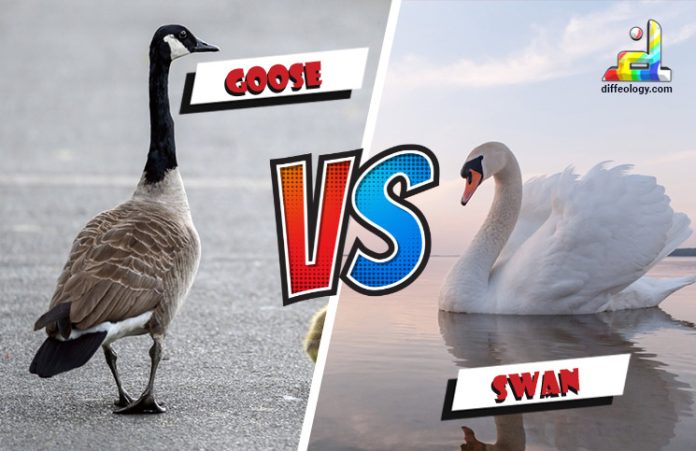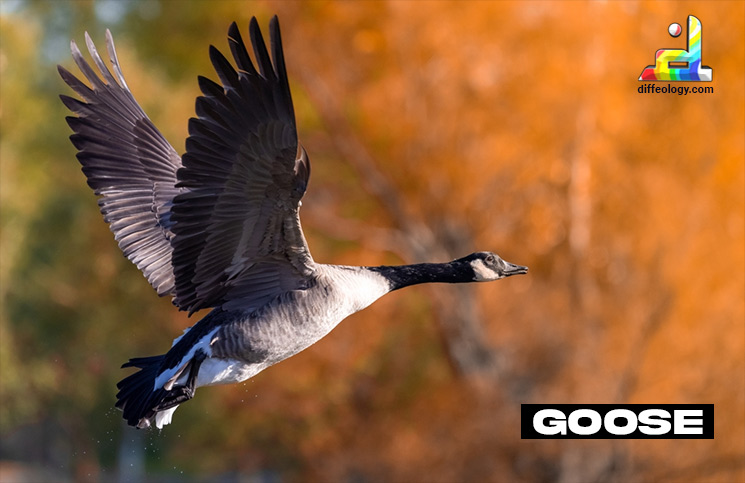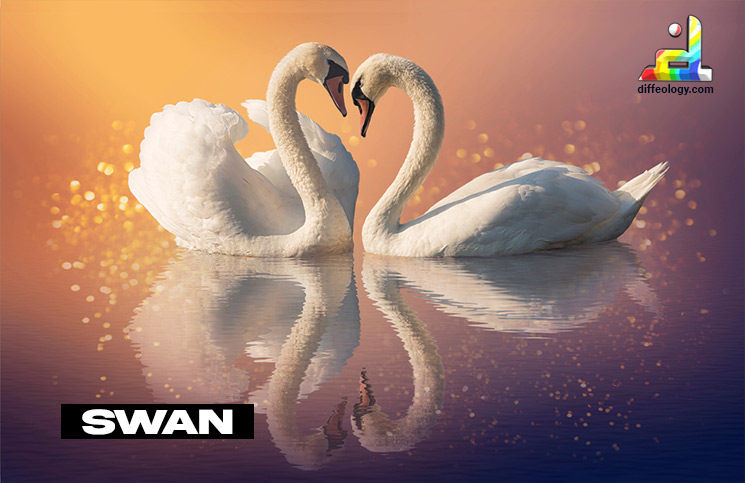See Mother Nature’s epic act, with geese and swans as the featured cast on waterways and sky. Knowing the Difference Between Goose and Swan is vital to distinguish themselves. These birds live in homes close to shorelines, but each one has its unique story, as depicted by the sounds produced by their beaks and the flapping feathers. We will be like detectives revealing the wonderful stories that these birds bring into the beautiful picture of nature that forms the basis of our research.
The Main Difference Between Goose and Swan
Geese are stocky with shorter necks. The swan is a known species with long necks and slim bodies. Generally, people see shades of brown, gray, and white associated with geese. Despite this fact, swans are famous for their brilliant white plumage, with the exception of a few species that may have darker-colored feathers. Geese need a big herd because it provides them safety as well as strength. Swans prefer nuclear families, living together in pairs for a long time.
Goose Vs. Swan
What is Goose?
Waterfowl comprise a variety of species, such as gooses, ducks, and others. That is almost like a duck but usually bigger. Geese honk and are seen everywhere – lakes rivers, among others. The legs of these birds have webbing and make good swimming. They can also walk on land.
Additionally, geese are social birds that typically travel in a flock. They may be observed soaring in a “V” format as they migrate. This species comes in many colors, including brown, ash, or gray, and white feathers are also not uncommon. Besides, some of the geese enjoy nibbling on grass or other vegetation, with a few taking to the waters for whatever they can find for a meal.
Read Also: Difference Between Sea Turtles and Land Turtles
Generally, geese are intriguing birds that have distinctive characteristics, social behavior, and peculiar honking calls, which render them unique.
What is Swan?
The swan is a nice-looking bird that moves smoothly over the surface of the water. A swan is a graceful bird with a long neck. Although swans are generally all white, some types have feathers of different colors.
They prefer quiet places, such as lakes and slow rivers, because swans don’t like disturbing noise. They possess large webbed feet that aid in easy swimming movements. It is common knowledge that swans tend to be very romantic; they find one mate, nest, and raise their young ones, referred to as cygnets.
Read Also: Difference Between Sheep and Lamb
Swans move stylishly whenever they do so. Two or a group of them can fly together, making some pleasant and graceful noise with their wingtips tapping on the air. The swan does not have only outer beauty but also has a “soft, trumpeting” voice, so it makes its picture more complete. Swans are one of the aristocracy in the kingdom of birds because they usually appear serene and elegant.
Comparison Table “Goose Vs. Swan”
| Physical Appearance | Short neck, robust build | Long neck, elegant silhouette |
| Feather Coloration | Browns, grays, whites | Striking white plumage, some darker hues |
| Neck Length and Shape | Short neck adapted for grazing on land | Elongated neck suited for underwater vegetation |
| Vocalizations | Loud, honking calls for communication | Melodious, trumpeting calls |
| Social Behavior | Form large flocks, rely on strength in numbers | Smaller family units, monogamous pairs |
| Habitat Preferences | Adaptable, thrive in various environments | Prefer larger, deeper bodies of water |
| Flight Patterns | V-shaped formations during migration | More solitary or small group flights with steady wing beats |
| Reproductive Behavior | Build ground nests, may nest in colonies | Build large, conspicuous nests near water’s edge, monogamous relationships |
| Bill Structure and Feeding Habits | Short, stubbier bills for grazing on grass | Long, slender bills for reaching submerged aquatic vegetation |
| Size and Wing Span | Smaller with compact wingspans | Larger with impressive wingspans for graceful flight |
| Migratory Behavior | Undertake extensive migrations in V-shaped formations | Migration varies; some sedentary species |
| Moving Around | Migrate in groups for long distances | Migrate or stay in breeding areas year-round |
| Feet and Swimming Style | Webbed feet with moderate webbing for stability | Extensively webbed feet for efficient propulsion in deeper water |
| Lifespan and Maturation | Shorter lifespan (10 to 20 years), mature quickly. | Longer lifespan (into the twenties or thirties), prolonged maturation period |
| Preferred Homes | Adaptable, live in various environments | Prefer serene lakes, slow rivers |
| Swimming Style | Webbed feet for stability on land and in water | Extensively webbed feet for smooth swimming in deep water |
| Moving Style | Travel in groups during migration | Travel alone or in small groups with slow, steady wing beats |
Difference Between Goose and Swan in Detail
1. Physical Appearance:
While geese and swans are both under a category known as “waterfowls,” there are marked differences with regard to their respective appearances. In most cases, geese possess short necks and strong bodies, creating a circular form with small feet, unlike swans that have elegant long necks with graceful carriage. Swans have less elongated bodies and long legs that make them look taller and very sophisticated.
They also have unique feather colors that distinguish them as well. They also differ in color, as geese normally present different shades of brown and gray, and swans famously stand out due to their white plumage. Some swans’ feathers would be black, but they would have striking white plumage as their main feature.
2. Neck Length and Shape:
The longest and slenderest necks distinguish geese from swans. Normally, geese possess shorter necks, making them more streamlined in appearance. They have their necks modified in such a manner as to enable them to access land-based grasses/vegetation near the shores.
Finally, swans distinguish themselves by having these elongated necks, thus giving them a royal look. Swans’ longer necks help them pull out water plants, especially those that grow deep down. Their feeding preferences are more inclined towards wetlands rather than being of the traditional land type as that with geese. In addition, the curved shape of a swan’s neck makes it even more beautiful while distinguishing it from the other waterfowls.
3. Vocalizations:
For example, geese and swans have different vocalizations. However, geese are famous for making a lot of noise that they refer to with a series of “honks” or “hanks.” For instance, these “honks” or “hanks” might be used to talk within the group, warning about dangers or expressing exiting. As extremely social birds, it is imperative that geese maintain a tight-knit group through their vocal call.
Contrary to this, swans produce more musical sounds. However, they may emit sounds of hissing and grunting while agitated but generally produce trumpet-like sounds for communication purposes. Their graceful and serene image is also brought about by these calls. These are usually among many swan calls that they employ during a courting period, as well as when communicating with each other, mating, and baby swans (cygnets). Another thing that distinguishes geese and swans is the unique noises they produce.
4. Social Behavior:
The birds behave differently in flocks. They like to move around in large groups of geese. Large groups travel, eat, and migrate together for mutual protection against other animals. As such, geese have strong family ties. Also, their method of gathering together is critical to their survival.
Swans also exhibit some degree of sociality and are grouped in small clans as well. They mate for a lifetime and co-rear their young. The swan is renowned for its fanciful courtship behaviors, which include synchronized swimming and tender gestures. Unlike geese that form bigger and more flexible groups, this type of gathering seems to be more family-oriented. Knowing how geese and swans relate through social interactions is what makes it interesting to comprehend their different behaviors.
5. Preferred Homes:
They both live in different kinds of places. The geese can dwell in a variety of areas, such as lakes, ponds, rivers, and even coastal environments. What is more, they can survive both in the urban environments as well as the cultivated areas.
In contrast, swans prefer bigger and deeper waters. They are usually found near quiet lakes, huge watersheds, and slow streams. These fish are eating plants that grow underwater, and these are more available in deep water than in shallow water.
6. Flying Styles:
Geese and swans have distinct flight patterns while in flight. The geese travel as V during migration. As far as energy conservation is concerned, this shape enables them to save more energy because it reduces the wind that the birds behind the leader would otherwise experience. On migration, geese have strong wings that are able to carry them farther.
In relation to swans, they are also good flyers but normally fly by themselves or in small parties. Unlike geese, egrets don’t take a V shape while flying. Their wings sweep at a slow pace and slow speed. During migration, swans may fly together with others of their species or with their small swan family. Thus, this explains the fact that swans are less arranged in society as compared with the larger groupings of the geese.# This knowledge of their flying habits gives us a glimpse into what swans and geese do up there in the sky.
7. Family Life and Nesting:
There are two ways in which some birds begin their families. Usually, geese build their nests on the ground, using plants’ stuff and feathers to conceal themselves. At times, they form clusters of settlements and construct their nests nearby. The gees work very hard caring for and watching over their young ones.
However, swans create bulky nests close to water. They make various nests using water plants and other materials in which to keep their eggs safe. It should be noted that a pair of swans normally do not split up, and they jointly create a nest and take care of their young ones. In this regard, this strong commitment to family life differs from gees that usually form breeding groups where each gender raises chicks communally.
8. Bills and Eating Habits:
Because of their bills, geese and swans also have different ways of eating. The bodies of geese are short and stout, which is ideal for consuming plants around the banks. These herbivores are chiefly plant eaters, feeding on the grass which they uproot using their bills. However, this is good for them since they like moving into fields and swamps looking for food.
However, swans possess longer and thinner bills, sometimes ending in a bulbous knob. These bills are perfectly adapted for growing underwater vegetation, particularly in deep water. The swans are dabblers (water plants and small water creatures). Swans have long necks and specialized bills that enable them to look for food underwater, a habit that is unusual from the land-based style of feeding like geese.
9. Size and Flying Style:
With regard to geese and swans, they differ in size as well as appearance during flight. Generally, geese are small birds with short necks and bodylines. Wing spans of swallows are more condensed when they take to air or can be seen roaming around on Earth. The fact that they have different sizes can easily be seen, thus adding a unique touch to their appearance.
However, swans are larger birds with longer necks, bodies, and wing spans. They fly elegantly and majestically because they have large wings. Swans fly long distances while taking fewer strokes of their wings, making it look effortless and smooth. Another thing that makes them look different is their size and wingspan.
10. Moving Around:
In addition, migratory movements in geese and swans are different. For their numerous migratory trips, geese are well-known. These birds usually move in V-shape formations, thus conserving energy as they migrate from the northern nesting grounds to the winter shelters.
Although most swans may also move around, they do not go that far like that of geese. However, the mute swan and some other swans are not ready to leave for winter and always stay at home in the breeding area. Other swans, such as the tundras, migrate an incredible distance – between their nesting grounds and their southern winter homes. The manner in which geese and swans adjust to various locations and weather conditions is evidenced by these differences in their movements.
11. Feet and How They Swim:
The type of feet affects swimming in geese and swans differently. Typically, geese have webbed feet; however, the webbing is not so wide. They enable them to maneuver freely on land as well as in water. Unlike other birds, gees prefer walking along the shores of lakes and eating in the shallow waters by the lake edge. Their webbed feet support stability while swimming.
In addition, swans are good swimmers because they have extensive webbing in their limbs. They have huge and useful webbed feet for efficient underwater motion. Swans are known to live most of the day in deep waters, spending their time swimming and searching for food, and the big webbing on their feet enables them to float across water without difficulty. The combination of the strong kicks from their legs and the big webbings makes swans appear graceful without any huffing.
12. How Long They Live and Grow Up:
There are disparities in the life span and the growth speed between the geese and the swans. Swans always live longer than geese normally do. This depends on whether it is a domestic or wild goose and may last for between 10 to 20 years. Goose’s babies grow up very fast sometimes. Most of them become adults within their first year of being born, while others have a baby just after that one-year period is over.
However, swans generally have a longer lifespan. Some swans may even make it up until their early eighties. Swans are also slow to mature. The majority of swans begin with parenthood at the age of 2-4 years. The longer life span and slow maturity rate further help in the formation of resilient family ties among swans.
Key Points Showing the Difference Between Goose and Swan
- Neck Length and Shape: Geese have short necks that help them eat grass on land. Swans have long necks that are great for reaching underwater plants in deep water.
- Vocalizations: Geese make loud honks to talk and warn each other. Swans have soft, musical calls that make them sound graceful.
- Habitat Preferences: Geese live in many places and are okay with different environments. Swans like bigger, deeper water areas, like calm lakes and slow rivers.
- Flight Patterns: Geese fly in V-shapes when they travel a long way. Swans fly alone or in small groups with slow, steady wing beats.
- Reproductive Behavior: Geese build nests on the ground and may have many nests close together. Swans build big nests near the water and stay with one partner for their whole lives.
- Bill Structure and Feeding Habits: Geese have short bills for eating grass. Swans have long bills for getting food underwater.
- Size and Wing Span: Geese are smaller with short wings. Swans are bigger and have long wings for graceful flying.
- Migratory Behavior: Geese travel in groups for a long distance during migration. Some swans travel far during migration, but others stay in their homes all year.
- Moving Around: Geese travel a lot in big groups. Swans might travel or stay in one place for the whole year.
- Feet and Swimming Style: Geese have webbed feet for stability in water and on land. Swans have big webbed feet for smooth swimming in deep water.
- Lifespan and Maturation: Geese live a shorter time, usually between 10 to 20 years. Swans live longer, with some living into their twenties or thirties, and they take more time to grow up.
FAQs: Goose Vs. Swan
Conclusion:
Looking back on our expedition for Difference Between Goose and Swan, it is apparent that nature’s piece of art involves a lot of diversity. Each feathered friend has their unique happiness in flocking and dancing, making the world more beautiful. We need to treat the environment well so that they can live together and be unique like our children. Then, let us continue admiring and conserving these gorgeous species for the sake of the coming generations.
References & External Links
- Goose Bird Facts
- Facts About Swans and What Do Swans Eat



